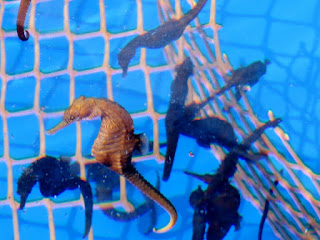"Rain, rain go away, come again another day."
(I'm sure our San Antonio friends can relate to this right now!)
 |
| Our morning view - lots of rain |
What has the head of a horse, a prehensile tail like a monkey, a kangaroo-like pouch and eyes like a chameleon? You can probably guess from the title of my blog (and it's not the liquid sunshine!).
The Big Island has an area I've been wanting to visit, but in 25 years of traveling to Hawaii Island, we never made it to the aquaculture area near the Kona International Airport. At the entrance to the aquaculture farms is the National Energy Lab, which is involved with some of the research.
The National Energy Lab studies making electricity using cold water from the deep ocean (3,000 ft down). The cold water is pumped to the Energy Lab and energy is generated by mixing the cold water with warmer shallow water. The mixing of the different temperatures creates electricity. This is called Ocean Thermal Energy Conversion (OTEC).
Businesses benefiting from pumping cold deep water to the business park are many aquaculture farms who are trying to farm endangered sea creatures: seahorses, sea dragons, lobsters, octopi, and abalone to name a few. These species on the edge of extinction got that way because of habitat destruction, pollution, and over-fishing to provide animals for the pet and medicine trades.
At 10 am this morning, we had a reservation to tour Ocean Rider Seahorse Farm. It was sprinkling when we arrived at 9:30 am. By 10 am, the sun was blazing hot and we were standing under it to listen to our tour guide.
The first thing she taught us is that seahorses eat brine shrimp, lots of them. So they grow their own brine shrimp at the farm in a turbid pool of salt water. A little later in the tour, we would get to feed the seahorses. She set about using a dip net to collect brine shrimp for us to see.
 |
| Looking out at the Pacific |
 |
| Our guide netting brine shrimp |
 |
| Here are the brine shrimp |
 |
| Quite a few people were on the tour |
Did you know seahorses are the only animals in which the there is a true male pregnancy, impregnated by the female? The seahorse pregnancy lasts 30 days. The seahorse has between 500-700,000 baby seahorses. You have to realize in the wild there are many predators. Even though seahorses are quite prolific, only 0.01% survive in the wild, that's one out of every 10,000. In captivity at the Seahorse Farm, they are getting a 50% survival rate and are able to supply most of the world's aquarium supply demand. This has cut down on the number of seahorses taken from the oceans by collectors who sell to the aquarium trade.
From the baby seahorses, we went outside to a covered area where larger seahorses were in blue plastic tanks. We learned that seahorses do not last long in captivity.
 |
| We were able to feed the seahorses brine shrimp |
Seahorses are monogamous and mate for life. When seahorses are separated from their mates they become depressed and die sooner. Seahorse Farms is raising seahorses in big social groups in tanks. If a seahorse pair becomes separated, the remaining seahorse realizes there are other fish in the sea, so to speak.
 |
| Social seahorses like to hang onto each other |
 |
| A pair of seahorses |
 |
| One of the owners showing me how to hold my hands to make them look like coral. |
 |
| Here I am with "my" seahorse. |
 |
| How cool is this? |
 |
| Bob now has a seahorse |
 |
| Bob with "his" seahorse |
When the tour ended, we were taken into a small sea horse and sea dragon museum. There are 20 different endangered seahorse species at the seahorse farm. Here are a few of my better photos. (It's hard to photograph these critters in their aquariums!)
 |
| Weedy sea dragons |
 |
| Weedy sea dragons |
We thought this tour was highly educational, not to mention fun and interesting. If you ever go to the Big Island, we recommend you visit the Ocean Rider Seahorse Farm.
I will continue this blog in Part 2.


















No comments:
Post a Comment
Please let me know what you think, your experiences, and constructive criticism to make this blog stronger.